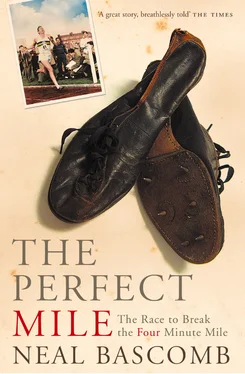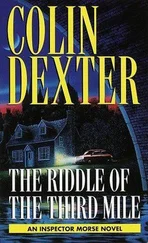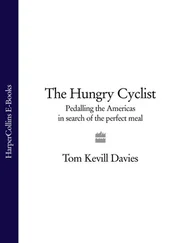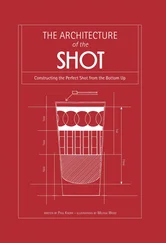When Macmillan, one of the most naturally gifted milers to appear on the Australian scene for years, showed up at Cerutty’s door on a Sunday morning, he was in a terrible state. He was failing his exams, having trouble finding time to train, and worried about his direction in life. Cerutty sat him down to talk about books, to discuss the Bible, and to argue philosophy. Then he gave Macmillan an ultimatum: ‘If you want to come work with me, be part of my gang, I’ll tell you straight out, I’m not interested in failures. You have to pass all your exams. That bit’s up to you, but if you want, I’ll tell you how to do it.’ He gave Macmillan an hour-by-hour schedule, directing him when to get up, drink his tea, run, study, take a shower, eat, run again, read the paper, and go to bed. Within a few months, Macmillan had passed his exams and won the Australian mile title in record time. At that same championship Les Perry came in first in the three-mile race.
When John Landy decided to make his way to South Yarra, Cerutty’s reputation was well established. As he led Landy up the stairs to his study overlooking Melbourne’s botanical gardens, the coach paused and, with a befuddled look, asked, ‘What did you say your name was? Landy? Gordon Hall told me you won the Combined Public Schools mile last year, and I always study the results … What was the time you ran?’
‘About 4:44 …’
‘I have never heard the name,’ Cerutty said, looking him straight in the eye. He sensed that Landy would resist taking direction. ‘It seems to me, young man, it is time you put the name of Landy on the world map.’
In a study measuring seven feet by seven feet and crowded with books, cherry red velvet couches, dumbbells, a decanter of port, a typewriter, and a hodgepodge of papers and magazines, Landy sat in silence as Cerutty dispelled the notion that Landy would burn out or, worse, harm himself if he trained too much. The ‘human organism’ was built to handle stress, he said; the body actually welcomed it. Through continuous effort, superior fitness was guaranteed. Look at the rigorous training of Emil Zatopek or the Finnish runners Arne Andersson and Gundar Haegg, he told Landy. Look at Percy Cerutty.
Landy was fired by his ideas. Nobody had ever spoken to him in this way. He told Cerutty that he would train with him. When Landy left, Cerutty simply noted on a card the young man’s date of birth and the mile time of 4:43.8 he had run in the 1948 Victorian Public Schools Championship. He filed it away in his athletics card catalogue, unaware that it was John Landy who would launch him into the international arena as a coach.
It took three weeks of hard training and a few lessons on running style for Landy to realise results. On 20 January 1951, he dropped his mile time by six seconds. Cerutty then gave Landy a training outline and sent him out on his own, never enquiring as to whether or not the young runner was following his guidance. And Landy did not feel the need to offer the information himself. The proof was in his performances. Two months later, after upper body strengthening with dumbbells and hundreds of miles of conditioning work, his time was down another ten seconds. On 22 May he ran a 4:16 mile, an extraordinary improvement. It was the first time Landy thought he might have a shot at the Olympics, though the qualifying time was 4:10. This ‘Conditioner of Men’, as the brass plate outside Cerutty’s house read, had discovered his greatest athlete yet. Landy had natural coordination, very strong leg muscles, and most importantly, he could sustain punishing levels of training. In this last respect, coach and athlete were much alike.
Almost from the day he was born in 1895, Percy Cerutty was a sickly child. His father was an alcoholic and his mother barely kept her son from malnourishment. Cerutty was plagued by pneumonia; his lungs barely functioned. Much of his youth was spent reading. He was continually nursed to health by his mother and sisters. At 15, when he took a job as a telegraph messenger boy, he had to ride his bicycle many miles into the suburbs, and he found that he enjoyed this. At 18 he won his first foot race. By the age of 21 he was experiencing brutal headaches that blurred his vision and made him vomit, yet he still raced, posting his best mile time of 4:34, just behind the fastest middle-distance runner in Australia at that time.
After he married and took up a career as a telephone technician, however, he hung up his racing shoes for the serious business of adult life. But soon the dreariness of that life began to sap his strength; he took to smoking and inactivity. The migraines worsened, his health deteriorated, and depression overpowered him. One day, at the age of 39, he stumbled into an empty church with tears pouring from his eyes. He had reached rock bottom. He was thin and weak with no hope but an early death.
His doctor recommended a six-month leave from the telephone company and gave Cerutty one prescription: ‘I can’t heal you with medicines, Percy … You have to save yourself. If you want to do anything about yourself, you’ll get off that bed under your own will and spirit.’ Cerutty took that advice seriously. He restricted his diet to raw foods and quit smoking. Perhaps most importantly, he started reading. He devoured everything from poetry to religious texts, weightlifting advice, Eastern philosophy, scientific treatises, and long-distance training guides. He developed a new approach to life, one unencumbered by fear and defined by exerting himself fully – physically, intellectually, and spiritually.
Mostly, though, he exercised. He lifted weights. He joined a walking club and began to take longer and longer hikes through the bush. Within a year he had completed a seventy-mile hike, to his wife’s shock. The outdoors exhilarated him. It was not long until he started to run again, and he ran constantly. Soon his body was transformed into that of a much younger man. In 1942, at 47, he showed up at the Malvern Harriers locker room and announced, ‘I’ve come down to have a run with you. I used to be a member here.’ Gone were the migraines, rheumatism, and spells of depression. The road hadn’t been easy though. When Cerutty had first begun exercising, he would return home on the brink of total collapse, his heart racing. He could hardly push open the front door. He would lie down on the floor, eyes glued to the ceiling as his breathing and heart rate gradually returned to normal. But he learned to appreciate the torture his body endured because he always recovered and returned stronger the next day. ‘Thrust against pain. Pain is the purifier,’ he said.
Within a year of joining the Harriers, he was regularly clocking mid-four-minute miles. Then came the marathons, 100-mile races in twenty-four hours, 200 miles in forty-eight hours. Such feats by a man of his age brought attention, and Cerutty adored it. He also welcomed the chance to expound his theories. As he codified his philosophy of training and life in the late 1940s, athletes were beginning to pay heed. In 1946 Cerutty purchased three acres in Portsea, a town south of Melbourne on the easternmost point of Port Philip Bay. There he began to build a ten-by-fourteen-foot hut and a larger shack out of lumber dismantled from shipping boxes. He would be a teacher.
By Christmas 1951, when John Landy walked up to the gate for his first and only visit to the Portsea property, Cerutty’s buildings and philosophy were complete. He didn’t train athletes; he guided ‘Stotans’.
The gate to the property was shut. Unlike the rest of the athletes at the camp, Landy had come down to Portsea on his own for the ten-day training session. His parents were circumspect about Cerutty, particularly because of his outlandish antics, but their son’s improvement as an athlete was undeniable, so they didn’t object to the trip. Seeing no lights on, Landy realised it was too late to catch anybody awake. He had brought a sleeping bag and, not wanting to disturb anyone, he found a hollow to sleep in. Because of the chill in the air, he donned every item of spare clothing he had brought, including his football socks, before slipping into his bag. He was all right until rain began to pelt his bag. Then it turned into a downpour. Shaking, wet to the bone, he stuck it out. By first light the hollow had turned into a streambed, and Landy stumbled into the camp, half in shock from the cold. The Portsea training had begun.
Читать дальше












